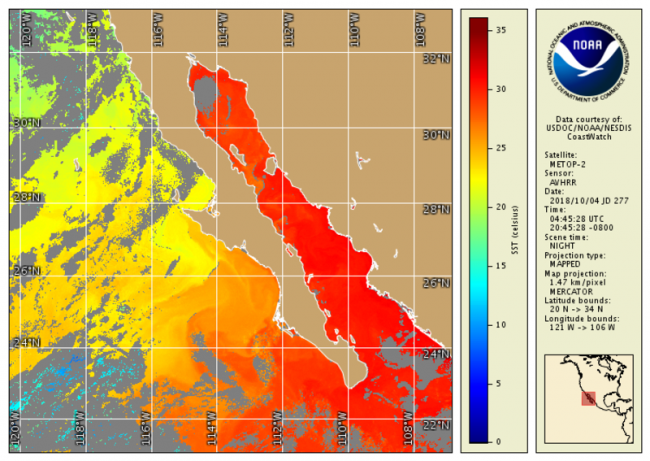The AVHRR FRAC SST data are produced from AVHRR/3s onboard Metop-A, -B and -C satellites using the NOAA Advanced Clear-Sky Processor for Ocean (ACSPO) v2.80 enterprise system, described in (Ignatov et al., 2016). Currently, near-real time (NRT) L2P and 0.02° L3U (gridded uncollated) data for Metop-A, -B and -C is produced at STAR (with ~2 to 6hrs latency). The data are being archived at PO.DAAC, and also available at this CoastWatch page as a 2 weeks rotated buffer. Metop-A mission officially ended at 2021-11-15 and the production of the ACSPO SST for the Metop-A ended at 2021-11-14 due to data degradation on 2021-11-15.
Data Access
Product Overview

he AVHRR FRAC SST data are produced from AVHRR/3s onboard Metop-A, -B and -C satellites using the NOAA Advanced Clear-Sky Processor for Ocean (ACSPO) v2.80 enterprise system, described in (Ignatov et al., 2016). Currently, near-real time (NRT) L2P and 0.02° L3U (gridded uncollated) data for Metop-A, -B and -C is produced at STAR (with ~2 to 6hrs latency). The data are being archived at PO.DAAC, and also available at this Coast watch page as a 2 weeks rotated buffer. Metop-A mission officially ended at 2021-11-15 and the production of the ACSPO SST for the Metop-A ended at 2021-11-14 due to data degradation on 2021-11-15.
The full-mission global AVHRR FRAC SST is produced from all three Metop First Generation satellites: A (2006-12-01 to 2021-11-14), B (2012-present) and C (2018-present), using the ACSPO enterprise system. Historical reprocessing (Reanalysis-1, RAN1) starts at the beginning of each mission and continues into near-real time (NRT). The L2P+L3U version of FRAC RAN1 is being archived in PO.DAAC.
The data are reported in 10min granule files in GHRSST Data Specifications v2 (GDS2) format, in swath projection (L2P) and 0.02° gridded L3U (U=uncollated), 144 granules per day, with a total data volume of 8GB/day for L2P and 0.4GB/day for L3U, respectively.
ACSPO retrievals are made in full AVHRR swath (~2,800 km). For data assimilation applications (such as production of L4 analyses, especially those that blend satellite and in situ data), correction for the Sensor-Specific Error Statistics (SSES; reported in ACSPO files; Petrenko et al., 2016) biases is strongly recommended.
In each valid water pixel (defined as ocean, sea, lake or river, up to 5km inland; note that in "invalid" pixels, defined as those with >5km inland, fill values are reported), the following layers are reported in both L2P and L3U: SSTs derived using multi-channel SST (MCSST; night) and Non-Linear SST (NLSST; day) algorithms (Petrenko et al., 2014); ACSPO clear-sky mask (ACSM; provided in each pixel as part of l2p_flags; Petrenko et al., 2010); SSES bias and standard deviation (Petrenko et al., 2016); NCEP wind speed for the NRT data and from MERRA-2 for RAN; and ACSPO SST minus reference (Canadian Met Centre L4 SST).
Only ACSM "confidently clear" pixels (equivalent to GDS2 "quality level"=5; also reported for each pixel) should be used. The ACSM also provides day/night, land, ice, twilight, and glint flags.
Both L2P and L3U SSTs are monitored and validated against in situ data iQuam (Xu and Ignatov, 2014) in SQUAM (Dash et al., 2010) and ARMS (Ding et al., 2017) systems, and BTs are monitored in MICROS (Liang and Ignatov, 2011).
Product Details
| Short Names |
AVHRRF_MA-STAR-L2P-v2.80
AVHRRF_MA-STAR-L3U-v2.80
AVHRRF_MB-STAR-L2P-v2.80
AVHRRF_MB-STAR-L3U-v2.80
AVHRRF_MC-STAR-L2P-v2.80
AVHRRF_MC-STAR-L3U-v2.80
|
|---|---|
| Temporal Start Date |
December 1, 2006
|
| Product DOI | |
| Temporal Coverage |
2-week rotated |
| Product Families |
Sea Surface Temperature
|
| Measurements |
Sea Surface Temperature - Polar-orbiting
|
| Processing Levels |
Level 2
Level 3
|
| Latency Groups |
0 Hours <= 24 Hours (NRT)
|
| Latency Details |
L2P: 3 hours |
| Spatial Resolution Groups |
100m < 2km
2km+
|
| Spatial Resolution Details |
L2P: 1km @Nadir; ~6 km @swath edge |
| Data Providers |
NOAA
NESDIS
STAR
|
Spatial Coverage
Global
| Description |
180W - 180E |
|---|
Processing Algorithms
ACSPO
| Description |
Advanced Clear Sky Processor for Ocean (ACSPO) is the NOAA Enterprise SST system |
|---|
Platforms
Documentation
Algorithms
Petrenko, B., A. Ignatov, Y. Kihai, P. Dash, 2016: Sensor-Specific Error Statistics for SST in the Advanced Clear-Sky Processor for Oceans. JTech, 33, 345-359, doi:10.1175/JTECH-D-15-0166.1
Petrenko, B., A. Ignatov, Y. Kihai, J. Stroup, P. Dash, 2014: Evaluation and Selection of SST Regression Algorithms for JPSS VIIRS. JGR, 119, 4580-4599, doi:10.1002/2013JD020637
Petrenko, B., A. Ignatov, Y. Kihai, and A. Heidinger, 2010: Clear-Sky Mask for ACSPO. JTech, 27, 1609-1623, doi:10.1175/2010JTECHA1413.1
Monitoring
Dash, P., A. Ignatov, Y. Kihai & J. Sapper, 2010: The SST Quality Monitor (SQUAM). JTech, 27, 1899-1917, doi:10.1175/2010JTECHO756.1, www.star.nesdis.noaa.gov/sod/sst/squam/
Ding, Y., A. Ignatov, I. Gladkova, M. Crosberg, and C. Chu, 2017: ACSPO Regional Monitor for SST (ARMS). BoM - NOAA SST Workshop, 18-21 April 2017, Melbourne, Australia (presentation), www.star.nesdis.noaa.gov/sod/sst/arms/
Liang, X. & A. Ignatov, 2011: Monitoring of IR Clear-sky Radiances over Oceans for SST (MICROS). JTech, 28, 1228-1242, doi:10.1175/JTECH-D-10-05023.1, www.star.nesdis.noaa.gov/sod/sst/micros/
Xu, F. & A. Ignatov, 2014: In situ SST Quality Monitor (iQuam). JTech, 31, 164-180, doi:10.1175/JTECH-D-13-00121.1, www.star.nesdis.noaa.gov/sod/sst/iquam/
Citation
The ACSPO AVHRR FRAC data are provided by NOAA STAR. We strongly recommend contacting NOAA SST team led by A. Ignatov before the data are used for any publication or presentation.
